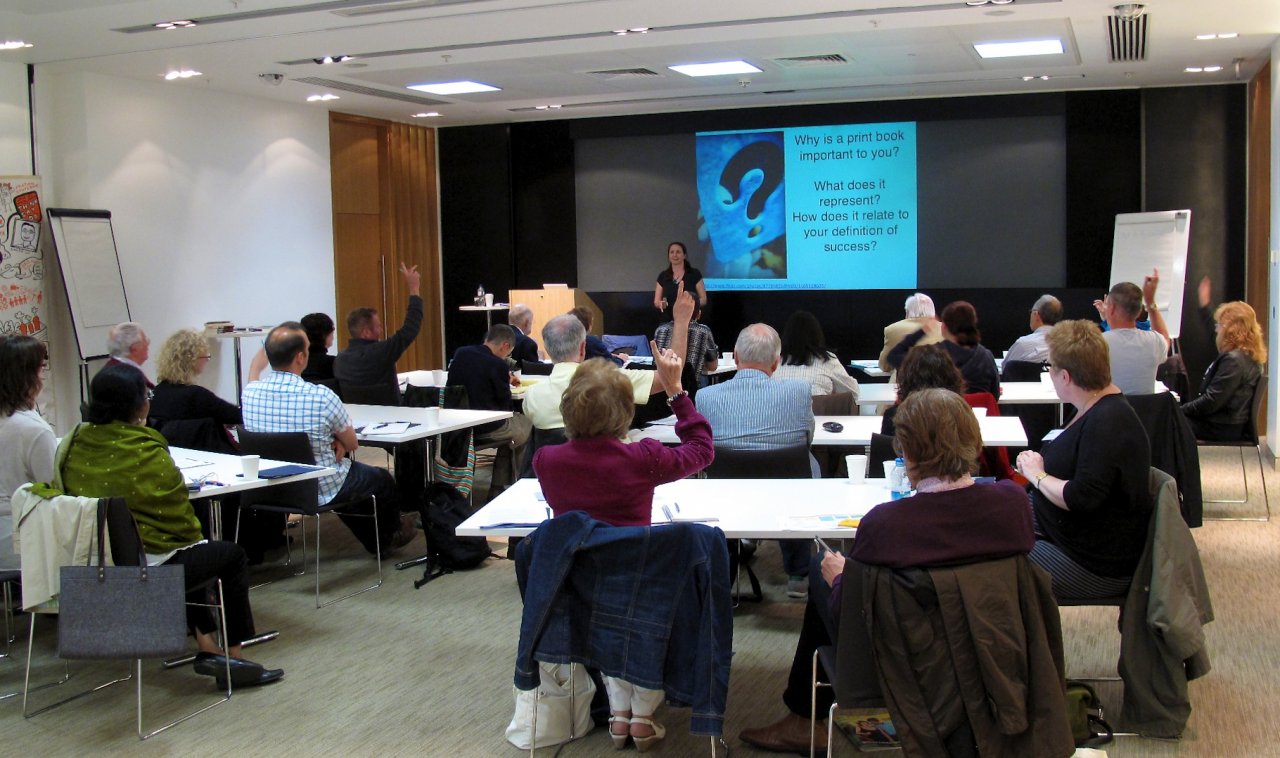On the great timeline of human events and inventions, ePublishing is yet a sliver among epochs. The history of the printing press goes back hundreds of years and the span of human communication and evolution of writing and language development encompasses thousands of years. But, the best you can do when discussing ebooks is to drop back a few decades to when character-mapped computer displays and painfully slow Internet connections were the order of the day. Like DVDs, electric hybrid vehicles, and cloud computing, the birthing cycle of ebooks has been a slow, steady progression rather than an explosive burst of achievement.
Something else is very clear about the nature of this technology: it is disruptive, promising to radically reshape publishing. In many ways, it already has and the publishing industry as a whole has been trying to either reject it or clumsily embrace it. Even when mainstream publishers embrace it, a fair amount of the time they clearly don’t get it. Like most large-scale corporations getting into social media, dipping their wing-tip clad toes into the swirling waters of Twitter, Facebook, and Pinterest, the concept eludes them and many try to shape their epublishing efforts into a replica of their print-publishing models, where authors without top tier status see no significant improvements to their royalties, promotional opportunities, editorial control, or stature. Authors exist under the mantle of the publisher, who contractually may exert a host of controls over their activities—the vast majority of them crafted to benefit the publishers’ fortunes—not the authors’.
One radical and breathtakingly disruptive idea stands out: ePublishing gives authors a platform to reach a prospective worldwide readership with near-weightless electronic books that can be delivered in seconds. This platform lets authors exert fine control over both their revenues and their relationships with readers through a multitude of social networking channels. While traditional publishers scramble to determine what value they can provide to interest authors within the disruptive tumult, authors are increasingly taking the independent road and building strong careers and long-term, expectant readerships around original work, conceived, marketed, and distributed under the direction of the each individual author. Without a publisher as an intermediary in the process, the author can receive royalty returns ranging from 30 to 100 percent, far more than anyone can expect from even the most generous print-publishing deal.
The Roots of the Technology
You might argue that the first invention to suggest the mechanisms to eventually drive ePublishing was the telegraph, with its innate ability to send words—in coded bursts—over wires. The mode of distribution, electrical signals over a conductive medium, is shared with ePublishing. But the comparison is flawed, since a telegraph typically involved one person communicating with another person–not exactly an example of publishing for the masses. And, of course, the telegraph lacks a fundamental strength of epublishing: to send a telegram, you are dependent on wires to complete the connection. With ePublishing, you can download ebooks and ezines wirelessly to a smartphone or laptop, whether you’re standing on a Philadelphia subway platform or sipping espresso at an outdoor cafe. You might think of this unique capability as unlimited access to a library in the sky stocked with millions of titles, all of them available in a flash.
This method of distribution has rendered mainstream publishers—with their trucking services, massive printing presses, shelf-space issues, and business models—largely obsolete. As most of them flounder around trying to insinuate themselves and add value in what has become a one-to-one transaction—from author to reader—the mechanisms of ePublishing continue to shift inexorably toward a fluid, socially driven framework.
It’s the distribution and storage methods for ebooks that lie at the heart of the technology and represent an incredibly important step forward in human communication. You can read about a new book in a blog post or on Facebook, click a link, and be reading the book in less than a minute. We’ve become used to this and it seems mundane—just as it seems a trivial thing to instantly check the weather in Sri Lanka or send a text message to someone hiking through the Adirondacks. But, it’s no small thing. And it’s the thing that will drive publishing in radical new directions and overturn some of the most cherished notions surrounding authors and books and reading. To some, this is heresy of the highest order. To others—particularly authors who have been largely shut out of the publishing game or treated badly while within it—the opportunities are expansive and energizing.
Printed books will never go away completely, but the wasteful, inefficient process surrounding their creation and distribution is unsustainable and a key driver of their diminished importance. When a traditional industry competes with its online rivals, agility and flexibility usually carry the day. The music industry was set on its ear by iTunes. Netflix rendered Blockbuster’s DVD rental process obsolete with video streaming and online selection. And as ebooks sales continue to seize a larger share of the market, brick-and-mortar bookstores are re-examining their business models to find a means of survival.
The Beginnings
Text can be stored and transmitted over the Internet in a remarkably efficient manner and some of the earliest uses of the Internet involved, students, researchers, and government organizations sharing papers, messages, and ideas with colleagues all over the planet. These communications were generally informal, ad hoc, and generally reliable, providing proof of concept that computers offered the promise of near-instantaneous communication that was practical and inexpensive.
Launched in 1971, Project Gutenberg, a pioneer in building a library of public-domain books, free to download for everyone, now has some 39,000 ebooks available in formats ranging from simple text to EPUB and PDF. In the matter of two or three hours, you could easily load up your iPhone or Android smartphone or laptop with enough books to keep you reading for the rest of your life. While there is no charge for these ebooks, Project Gutenberg encourages its patrons to make donations and to get involved in converting print versions of public-domain titles to ebooks. Michael Stern Hart, now deceased but thought of by many as the founder of the ebook, took a favorite quote from George Bernard Shaw to heart in his philosophy:
“Reasonable people adapt themselves to the world. Unreasonable people attempt to adapt the world to themselves. All progress, therefore, depends on unreasonable people.”
The first commercial device that could reasonably be called a handheld ereader came from Franklin Electronic Publishers. Launched in 1986, the Franklin Spelling Ace let users type in a word phonetically on the keyboard and the word appeared, correctly spelled, including an audio pronunciation. Franklin followed up with a number of devices, including the compact Bookman, a searchable version of the complete bible. The Rocket e-Book appeared in 1998, marketed by Franklin with the tagline “A world of books in the palm of your hand.”
It took Sony and the Amazon Kindle to launch the serious start of the ebook revolution several years later. Now there are dozens of standalone models available, as well as free software that enables most electronic devices with a screen (smartphones, laptops, tablets, and so on) to access and view either DRM-protected or open ebooks directly.
Experiments Along the Way
When Internet access for most meant dial-up connections, with modest dial-up speeds of anywhere from 2.4 kilobits per second to 28.8 kbit/s, CD-ROMs enjoyed a brief flurry of popularity as the medium of choice for epublishing. Infobases, encyclopedias, multimedia references, collections of public domain ebooks, and similar content was released as the boom progressed. But, as higher speed Internet access become more available, the benefits of CD-ROMs—with the associated physical distribution issues—became less compelling. EPublishing began shifting more toward a web-oriented model as ezines, early ebooks, and reference materials became conveniently accessible through simple downloads.
With the Adobe Portable Document Format (PDF) firmly entrenched as the leader in maintaining page fidelity representing complex pages that include graphics and elaborate formatting, it is easy to forget that for awhile there were turf wars over which technology would predominate in this space. Throughout the 1990’s, rival document formats appeared and disappeared, including AnyView from Binar Graphics company, Common Ground from No Hands Software, Folio from NextPage, Envoy from WordPerfect Corporation, WorldView from Interleaf, and others. Who really remembers any of these competitors?
Even now, Microsoft occupies a small niche in this area with their XPS format—a competitor to PDF—which is still supported in Windows 8, but use of this format appears miniscule in comparison with the ubiquitous PDF. You can generate an XPS file from within most Windows applications by printing to the XPS Document Writer, which creates a portable .xps file, readable in the XPS viewer or Internet Explorer. It remains to be seen whether Microsoft can increase the popularity of XPS any time soon.
The Future
Current trends point toward a shift in dedicated ereader use that favors the new breed of “smart, connected devices,” which, according to IDC grew 27.1 percent over the previous year while ereader sales are expected to drop 36 percent, based on estimates from IHS iSuppli. The publishing standards around ebook delivery continue to evolve, with EPUB3 and HTML5 rapidly gaining strength in the market, but universal adoption of any single standard any time soon looks fairly unlikely.
Quoted in a Good EReader post, Matt Edelman from Glossi said, “I don’t think there is anything driving the various members of the digital publishing ecosystem to proactively choose a unified platform. Not even consumers would benefit from that. Just as some people prefer hard cover books over ANY digital alternative, so too will segments of consumers continue to gravitate towards publications that offer unique value specifically because of the platform on which they are published. And as long as there is a market for more than one alternative, there will be suppliers for that market.
“What does seem clear though is that the web itself is becoming the publishing platform of choice as it matures. That suggests HTML5 may become the most dominant platform, largely because it would be the most economical one.”
Nonetheless, the success of ePublishing is not necessarily tied to devices, standards, platforms, or distribution and delivery methods. Regardless of the direction in which the market evolves, the ingenuity and imagination of authors, independent publishers, new school ezine creators, and other innovators on the digital scene will conceivably drive the more interesting developments in the industry. Any predictions we can make about the future will pale before the ongoing accomplishments of those creators who are finding ways to push through the barriers, exploit the latest opportunities, find readers in unexpected ways, and help develop new models of compensation for their creative efforts.
Photo credit: Creative Commons licensed by powazny





